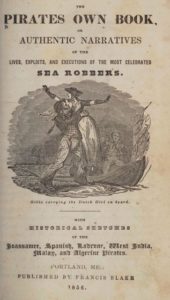Ellms’s writing style further undermines any presumption that all pirates are bad. Although he lifted from newspapers, pamphlets, and Johnson’s General History, Ellms modernized the language and punched up the drama. Readers are made to sweat, scream, and cringe at the actions of scallywags; they are put in the moment with the pirates. Compare two scenes from Mary Read’s life, one from Johnson and one from Ellms. In both, the pirate Mary Read has fallen in love with a young sailor, revealed herself as a woman, married him, and then decided to fight her husband’s challenger instead of risking his death. According to Johnson, Mary “was to the last Degree uneasy and anxious, for the Fate of her Lover; she would not have had him refuse the Challenge, because, she could not bear the Thoughts of his being branded with Cowardise; on the other Side, she dreaded the Event, and apprehended the Fellow might be too hard for him.” Johnson continues on about the nature of love, finally ending with Mary meeting the man who will duel with her lover, and fighting him “at Sword and Pistol, and [killing] him upon the Spot.” The scene belabors Mary’s emotions, presenting them both formally and in universal terms, only to hurry through her murderous action.
Ellms alters this formula. In his account, we get to the major event (Mary’s killing of the lover’s challenger) in almost half the words. What comes before serves as succinct motive for that deed: Mary “manifested a greater concern for the preservation of his life than that of her own.” Ellms also emphasizes the story’s action with an engraving of Mary thrusting her sword straight through the man’s belly. (Figure 6) Ellms drew most, if not all, of these 18 full-page engravings and 48 partial-page engravings (though someone else would have engraved them). Although some are merely decorative flourishes, most of the images capture dramatic moments, including Captain Condent leaping into the hold to kill an attacker, Charles Gibbs abducting a young woman, and a group of pirates burying treasure. In addition to emphasizing the story action, some of these images are so visually effective that they have become the dominant visual of the pirate. (When one does an internet search for Mary Read, Ellms’s image appears at the top of results. Ditto with Captain Kidd.) Picture yourself in the story, Ellms tells his reader. Immerse yourself in this conjured world: sweat, scream, and cringe with these pirates. Perhaps it is not too much further to imagine oneself as a pirate and, one day, the subject of just such a story.







